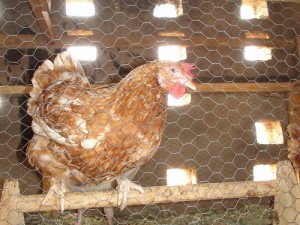A recent article in the New York Times highlighted efforts to limit the industrial farming practice of confining animals in close quarters. The movement is gaining momentum in big animal agriculture states, including Ohio and California.

The public has become increasingly aware of the ongoing debate between industry and animal rights advocacy groups, especially on whether “allowing animals to express natural behaviors” is a necessary criterion in determining animal rearing practices. (Photo credit: Bernard Pollack)
Previous Nourishing the Planet blog posts have discussed the recently passed bill on cage-free eggs in California, and also FDA’s judicial guidance for the industry on antibiotic use in animal agriculture. Popularity of documentaries such as Food, Inc. and Fresh have brought the knowledge of what goes on behind the doors of factory farms into the mainstream. The public has become increasingly aware of the ongoing debate between industry and animal rights advocacy groups, especially on whether “allowing animals to express natural behaviors” is a necessary criterion in determining animal rearing practices.
Industry groups including the United Egg Producers state that their standards are sufficient and there is no scientific evidence that quality of life for animals affects the quality of the product. On the other hand, independent certification systems such as Certified Humane place emphasis on animals having access to natural components in their environment.
While paying attention to the way we treat animals is important, there is potential that the debate on animal rights may hinder the process of change in the industrial farming system, as it remains unclear when scientific evidence condoned by both sides will surface.
But serious and undeniable effects of industrial agriculture remind consumers and producers that change cannot wait. There are, as said by hog farmer Irv Bell, “bigger things at work.” Lessons from avian flu, swine flu and foot-and-mouth disease have shown us that animals placed in close proximity in confined quarters are a welcoming breeding ground for new diseases. According to the United Nations Food and Agriculture Organization (FAO), production of livestock and feedstuffs is responsible for some 80 percent of all agricultural greenhouse gases, with emissions several times higher in developed than in developing countries. And the selection of a few livestock breeds for mass production to maximize production of meat and dairy is directly linked to the loss of livestock biodiversity – on average, two domestic animal breeds go extinct every week.
Positive examples in alternative livestock rearing systems such as rotational grazing and improved manure management show us that it is possible to raise livestock sustainably. To learn more about efforts towards humane, sustainable animal rearing practices, see Mexican Activists Pushing for Factory Farm Regulations, Innovation of the Week: Using Livestock to Rebuild and Preserve Communities and Livestock Keepers’ Rights: Conserving Endangered Animal Genetic Resources in Kenya, Creating a Roadmap for Environmentally Sustainable Meat Production and Consumption, The Keepers of Genetic Diversity: Meeting with Pastoralist Communities in Kenya and Happier Meals: Rethinking the Global Meat Industry.
Prepared by Alex Tung, a food and agriculture research intern with the Nourishing the Planet project.

Danielle Nierenberg, an expert on livestock and sustainability, currently serves as Project Director of State of World 2011 for the Worldwatch Institute, a Washington, DC-based environmental think tank. Her knowledge of factory farming and its global spread and sustainable agriculture has been cited widely in the New York Times Magazine, the International Herald Tribune, the Washington Post, and
other publications.
Danielle worked for two years as a Peace Corps volunteer in the Dominican Republic. She is currently traveling across Africa looking at innovations that are working to alleviate hunger and poverty and blogging everyday at Worldwatch Institute’s Nourishing the Planet. She has a regular column with the Mail & Guardian, the Kansas City Star, and the Huffington Post and her writing was been featured in newspapers across Africa including the Cape Town Argus, the Zambia Daily Mail, Coast Week (Kenya), and other African publications. She holds an M.S. in agriculture, food, and environment from Tufts University and a B.A. in environmental policy from Monmouth College.








